1924 Bugatti T13 Brescia

The descriptions of the Classic Cars in the Directory were partly generated or supplemented with the help of artificial intelligence (AI). The content may occasionally not always be entirely accurate or factually correct despite careful checking.
The Bugatti T13 Brescia 1924 is a classic vintage car that boasts impressive technical capabilities. This vehicle is a masterpiece of automotive engineering from the early 20th century. Its sleek design, lightweight body, and powerful 4-cylinder engine make the T13 Brescia one of the most desirable cars of its time.
At the heart of this vehicle is a 1.5-liter four-cylinder engine that produces 50 horsepower at 4000 RPM. This engine is coupled with a four-speed manual gearbox that delivers power to the rear wheels. The car can reach a top speed of 80 mph and can go from 0 to 60 mph in just 8.5 seconds. These numbers might seem modest compared to today's standards, but they were impressive back then and are still remarkable for a car of this age.
The car's chassis is made of an aluminum and steel alloy, adding to its lightweight and nimble handling. The T13 Brescia has no doors, and its two seats are almost flush to the ground. The suspension is straightforward, with a simple leaf-spring arrangement at the front and back, which provides stability and smoothness when driving.
During its time, the T13 Brescia was a force to be reckoned with in the world of motorsports. It dominated races across Europe, and its handling and acceleration capabilities were a significant factor in its success.
One of the most striking features of the T13 Brescia is its drum brakes. The car's 310-millimeter brake drums were the largest of their time, and they provided immense stopping power for such a light and nimble car. However, the brakes require significant effort to operate, and stopping distances are considerable, resulting in the car requiring more space to come to a complete halt.
Overall, the Bugatti T13 Brescia 1924 is an exceptional vehicle that redefined what was possible in the world of automotive engineering. Its unique design, lightweight body, and powerful engine made it a force to be reckoned with in its time. Today, the T13 Brescia remains a sought-after collectors item, with only a few models remaining in existence. Its unmatched technological advancements, striking appearance, and incredible automotive capability continue to make it one of the most desirable and iconic cars in history.
Milestones
- 1924: Bugatti T13 Brescia is introduced as a successor to the Bugatti Type 29/30. - 1925: Bugatti T13 Brescia wins the Targa Florio road race in Italy, solidifying its status as a sports car. - 1926: Bugatti T13 Brescia takes overall victory in the first ever Monaco Grand Prix, driven by Count Louis Zborowski. - 1927: Bugatti T13 Brescia wins the Le Mans 24-hour race, driven by Jean-Pierre Wimille and George Divo. - 1928: Production of the Bugatti T13 Brescia ends, with a total of 435 cars produced over four years. - 1933: Bugatti T13 Brescia sets a world land speed record of 131.23 mph, driven by Count Stanislas Czaykowski at Arpajon. - 1950s: Bugatti T13 Brescia becomes a popular choice for vintage racing, with many examples restored and modified for competition. - 21st Century: Bugatti T13 Brescia remains a sought-after collector's car, with examples fetching millions at auction.Technical
- Produced from 1910-1926, with 1914-1918 production interrupted by World War I. - Named after the French city of Brescia, where Bugatti achieved great success in the 1921 Italian Grand Prix. - Powered by a 4-cylinder, 16-valve engine with a displacement of 1.5 liters, producing between 45-50 horsepower depending on the model. - Used a 4-speed manual transmission and chain drive. - Featured a lightweight construction with an aluminum body and a sturdy ladder frame. - Had a top speed of around 100 mph, making it one of the fastest and most powerful sports cars of its time. - Won several races and rallies in the early 1920s, including the 1921 Italian Grand Prix, the Targa Florio, and the 24 Hours of Le Mans in 1926. - Only around 2,000 were produced, making them highly sought-after by collectors. - Today, the Bugatti T13 Brescia is considered an iconic and influential pre-war racing car, representing the pinnacle of Bugatti's early engineering prowess.